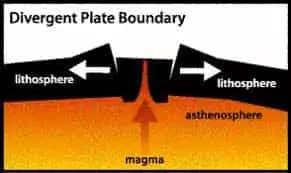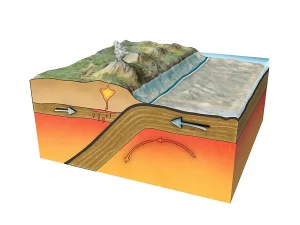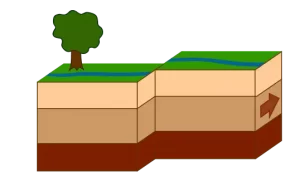Table of Contents
An earthquake may be defined as the sudden shock of the earth that emits the energy in the earth’s lithosphere causing the formation of seismic waves.
Before knowing more about earthquake, let’s know how it is caused. The earthquake can be caused due to volcanic eruption, the moving of tectonic plates, the formation of a cave in a small area, or due to explosions.
It is determined with the help of a seismograph by Seismometer and is measured on the Richter Magnitude Scale.
1. Occurance of Earthquake
Here we will discuss about earthquake occurrence in points:
a. The main cause of earthquakes is due to immediate tectonic movements in the earth’s crust.
b. When the tectonic plates present in the earth move/passes over one another, there is a cause of orogeny which outcomes in earthquakes and volcanoes.
c. These processes cause vibrations that move in all directions. As there is a relative motion of these plates, there is the formation of stress, which splits by emitting the collected energy known as shock waves.
d. This causes emits of energy, and the energy waves move in all directions. The place where the energy is emitted is known as the focus of an earthquake or hypocentre.
e. The place on the earth’s surface which is vertically up the focus is known as the epicenter. It is the starting point to having the waves.
2. Causes of Earthquake
The causes of the earthquake are as follows:
a. When the tectonic plates present in the earth move/pass over one another plates.
b. Due to a big explosion.
c. Due to Minning.
d. Driving Heavy weighted Vehicles.
e. Testing of bombs, nuclear, etc.
3. Tectonics Plate All Over The World
There is a number of plates categorized as major, minor, and micro tectonic plates.
There are seven major plates which are as follows:
a. African
b. Antarctic
c. Eurasian
d. Indo-Australian
e. North American,
f. Pacific
g. South American.
4. Types of Plate Boundary
There are three types of plate boundaries:
a. Divergent: plates moving apart

b. Convergent: plates coming together

c. Transform: plates moving past each other

5. Types of Fault
The types of faults are as follows:
a. Normal Fault
Normal, or Dip-slip, faults may be defined as inclined cracks where the blocks have majorly moved vertically. The hanging wall moves downward.

b. Reverse Fault
A reverse fault is also known as a thrust fault if the dip of the fault plane is tiny. In a reverse fault, the earth on one side passes up and over the other side.

c. Strike-Slip Fault
The strike-slip fault is also known as a transcurrent fault, wrench fault, or lateral fault. Strike-Slip faults are vertical or nearly vertical cracks where the blocks have majorly moved horizontally.

6. Effects of Earthquake
Here we will discuss earthquake effects that are as follows:
1. Ground Shaking
At the time of an earthquake, seismic waves emitted move horizontally or vertically causing the movements of structures in all directions.
Due to this, the structure gets weak by preparing the joints lose and sometimes have tilting/collapse of a structure which may guide to death of the life of people, animals, and, property.
By using the ground accelerator; ground shaking is determined.
2. Liquefaction of Soil
At the time when water-saturated granular material like sand drops its strength for the moment; it gets changed into a liquid state from solid and hence liquefaction occurs.
This generally occurs sinking and tilting of rigid structures like bridges, buildings, etc.
3. Settlement of soil
The movement of an earthquake works like a realistic vibrator causing the separation of air voids from soil and changing of water present in soil from one point to another point with the help of natural pressure. This causes the settlement of soil to a high degree.
It results in the settlement, tilting, and sometimes may lead to the complete collapse of structures.
4. Ground Rupture
Ground rupture is the visible cracking and fracture on the earth’s surface along the trace of the fault, which can be bigger or smaller in size.
During the earthquake, stresses are emitted into the ground guiding to ground rupture.
Man-made structures like dams, nuclear power stations, bridges, tunnels, pipelines, roads, etc are in high danger of ground rupture.
5. Landslides
An earthquake causes the slope to unbalance by vibrating the slopy land in all directions. This leads to landslides that outcome in the death of thousands of lives and the loss of properties.
The bigger landslide nearly damages the hill fully.
Due to an earthquake, Rockfall can occur which is a type of dry landslide.
6. Flood
Effects of an earthquake which can lead to landslides, splitting down of dams, etc can cause a disturbance of movement of rivers that can lead to a flood.
Due to the earthquake, Glacier bursting occurs.
7. Human Impacts
When an earthquake lasts for a longer time and its magnitude is high. this can lead to health issues like heart issues, panic attacks, and depression in survivors.
Earthquake is so immediate that many people do not get the chance to go out in the open and wide area.
8. Tsunami
A tsunami may be defined as a series of huge waves occurred by the displacement of a large volume of water because of an earthquake in an ocean or lake, a volcanic eruption in the sea or ocean, and many more reasons.
About 80% of tsunamis occur in the Pacific Ocean.
Major countries like Japan, the USA, Hawaii, etc are very prone to the risk of tsunamis. Landlocked countries are safe from tsunamis.
An earthquake of 7.5 magnitudes or more can help a tsunami to occur.
9. Fires
There is a high chance of fire during the time of the earthquake.
The earthquake may guide to the splitting down of electrical supply, gas pipelines, etc which may cause a fire.
If the fire starts, it will be very hard to handle it from expanding.
On the date of 1906, during the San Francisco earthquake; many people died due to the effect of fire than an earthquake.
7. Most Earthquake Prone Countries
Here we will discuss earthquake-prone countries as follows:
| Japan | Nepal | India |
| Ecuador | Philippines | Pakistan |
| El Salvador | Mexico | Turkey |
| Indonesia | ||
8. Way To Stay Safe During Earthquakes
Here are a few points that you can use to protect yourself from the earthquake.
a. Avoid the use of elevators.
b. Stay away from utility wires.
c. Way to clear the area and avoid bridges.
d. Cover your head and Neck.
e. Get Under the desk and hold on.
f. Use pillows or mattresses to protect yourself.
9. Places To Hide During Earthquake
The safe places where you can hide are as follows:
i. Tables and Study Desks
ii. Room Without Windows
iii. Bed or Closet
iv. Door frame (as a shelter during the earthquake)
v. Outside Open Spaces
10. Places Not To Hide During Earthquake
The place where you shouldn’t stay is as follows:
1. Stay far from the outer walls, windows, sharp objects fireplaces, and hanging objects.
2. Stay away from telephone lines, Electric wires lines.
3. Don’t stay near the ocean, the sea moves to higher places.
4. Don’t lie down under the bed.
11. Prediction of Earthquake
Earthquake warning systems have been introduced that can give regional notification of an earthquake in progress, but before the ground surface has started to shake, potentially permitting people within the system’s range to look for shelter before the earthquake’s impact is noticed.
This was for About Earthquake.
12. References1. Content Filter & Authenticity Checking Team, Dream Civil International (Our team checks every content & detail to maintain quality.) |
| Read Also: Effects of Earthquake |

